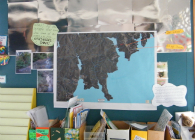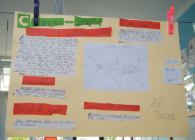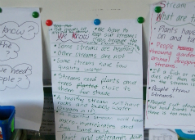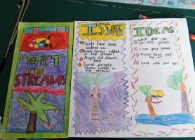Session 3
Learning Outcomes
At the end of the session students will be able to…
1. identify some of the animals and plants in their local stream
2. understand some of their habitats and life cycles
3. describe the relationships between the plants and animals (food webs) and their reliance on a healthy habitat
Resources
WaiCare resources (see your local Wai Care facilitator)
Stream testing recording sheets:
http://www.gw.govt.nz/assets/Get-Involved/TAFW-Exploredaysection.PDF
Environment Waikato – How Clean is Our Local Stream
http://www.ew.govt.nz/PageFiles/5937/Rivers_howCleanIsOurStream.pdf
Take Action for Water – Native Ecosystems
http://www.gw.govt.nz/assets/Get-Involved/TAFWNativeecosystemssection.PDF
Curriculum links
Key competencies
• Using language, symbols and texts
• Relating to others
Science, English, Maths, Health
Activities
1. Plan a trip to your local stream
• Contact your local Wai Care facilitator (well beforehand if possible) for support with assessing the health of your stream using simple water quality monitoring techniques and identifying ‘bugs’.
• Record beforehand what students expect to see in and around their stream.
* Do they know if the water is clean or dirty?
* What could they look at to check the quality?
• During the trip
* take photos
* test water quality
* What lives in the stream? Identify from samples. Record observations.
* Observe how the water flows and which way. Where is the water going?
* Observe the stream side. Record plants, animals, bird life. Sounds?
• After the trip
Discuss and share:
How clean is the stream?
What lives in the stream?
What lives beside the stream?
Use these stream testing resources to record your results:
http://www.gw.govt.nz/assets/Get-Involved/TAFW-Exploredaysection.PDF
2. Become a stream animal expert
• Students choose one of the following animals
banded kokopu
longfin eel
cased caddisfly
mayfly
• Explain that they will become an expert on this animal and write a report on it. Check the Take Action resource: Native Ecosystems BLM 7 & 8 for a writing planning sheet for students:
http://www.gw.govt.nz/assets/Get-Involved/TAFWNativeecosystemssection.PDF
Provide students with a report writing checklist suitable to their level.
• Students share what they know already about their animal.
• Brainstorm the main features of an insect. Refer to the above resource on Native Ecosystems (Aquatic insects and their life cycles).
• Discuss life cycles with students and give them a couple of examples for the Native Ecosystems resource: BLM 9 Insect Life Cycles and use this to answer the questions on BLM 9
• Divide students into four groups according to their animal they have chosen (BLM 16, 17, 18, 19 from the above resource). Share the information and then use BLM 20 to complete the questions.
3. Food webs
• Brainstorm what animals eat. Use think, pair and share.
• Introduce the concept of a food web. Give an example and get children to come up with their own. Include humans.
• Give students the animal food web cards (BLM 13) from a water catchment to cut up and put on BLM 14. You will need to explain the key on BLM 14
• Give students BLM 15 to work on in groups. You may wish to do this activity as a class (especially younger students). Students could also role play the creatures.
4. Stream plants
• What plants grow beside our stream? Check notes and photos from your stream visit. List them.
• Why are plants important to stream life? Think about the leaves, branches, logs, roots, fruit, nectar from flowers … List students’ ideas.
• Give students a copy of BLM 11 to complete in small groups or pairs. Share answers and discuss as a class.
Assessment
• Each student completes the report writing on their animal. Use BLM 8 to draft their report before publishing their work. Use the checklist for assessing students’ work.
Additional information: Waitakere City’s streams
Waitakere City still has a good network of streams. Many stream systems in are still in a natural state with good vegetation, important for migratory species of native fish, such as inanga and other galaxids (banded and giant kokopu).
The most common native fish species found in our streams are short-finned eel, long-finned eel, common bully, banded kokopu, inanga, redfin bully and common smelt. Uncommon species are Crans bully and giant kokopu.
Among the less frequent species found in urban Waitakere streams are the freshwater crayfish or koura, the freshwater crab and giant kokopu. Recently, the regionally rare shortjawed kokopu was discovered in a stream in the Waitakere Ranges.
Reserves, particularly bush reserves, function as wildlife refuges, breeding areas and seed source for the regeneration of native bush. For the bush area to support small bird species, such as fantail and grey warbler, as well as a rich variety of invertebrates there does need to be a dense under storey and good ground cover. However, a one or two tier canopy will still attract tui and other wider-ranging species.
 |
 |
 |
| Session 1 Up the Creek |
Session 2 Wai … it goes round and round |
Session 3 Oh for a cool stream! |
 |
 |
 |
| Session 4 Hey! Watch where you chuck your muck! |
Session 5 Time to Come Clean |
Session 6 We’re Scheming for a Clean Stream |

